7.2: Sum and Difference Identities
( \newcommand{\kernel}{\mathrm{null}\,}\)
Skills to Develop
- Use sum and difference formulas for cosine.
- Use sum and difference formulas for sine.
- Use sum and difference formulas for tangent.
- Use sum and difference formulas for cofunctions.
- Use sum and difference formulas to verify identities.
How can the height of a mountain be measured? What about the distance from Earth to the sun? Like many seemingly impossible problems, we rely on mathematical formulas to find the answers. The trigonometric identities, commonly used in mathematical proofs, have had real-world applications for centuries, including their use in calculating long distances.
The trigonometric identities we will examine in this section can be traced to a Persian astronomer who lived around 950 AD, but the ancient Greeks discovered these same formulas much earlier and stated them in terms of chords. These are special equations or postulates, true for all values input to the equations, and with innumerable applications.

Figure
In this section, we will learn techniques that will enable us to solve problems such as the ones presented above. The formulas that follow will simplify many trigonometric expressions and equations. Keep in mind that, throughout this section, the term formula is used synonymously with the word identity.
Using the Sum and Difference Formulas for Cosine
Finding the exact value of the sine, cosine, or tangent of an angle is often easier if we can rewrite the given angle in terms of two angles that have known trigonometric values. We can use the special angles, which we review in the unit circle shown in Figure
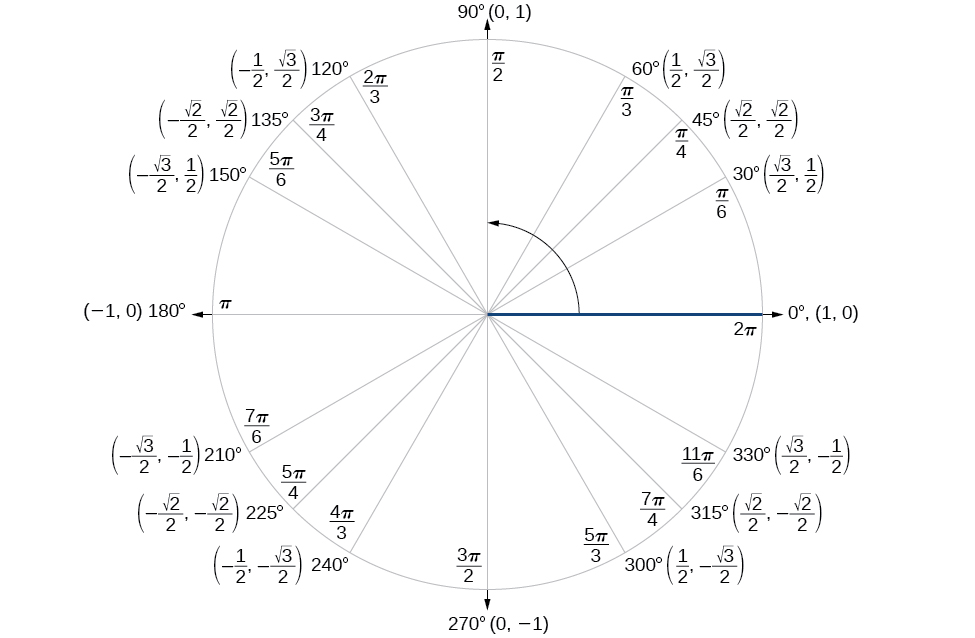
Figure
We will begin with the sum and difference formulas for cosine, so that we can find the cosine of a given angle if we can break it up into the sum or difference of two of the special angles (Table
| Sum formula for cosine | |
| Difference formula for cosine |
First, we will (almost) prove the difference formula for cosines. Let’s consider two points on the unit circle (Figure
Label two more points:
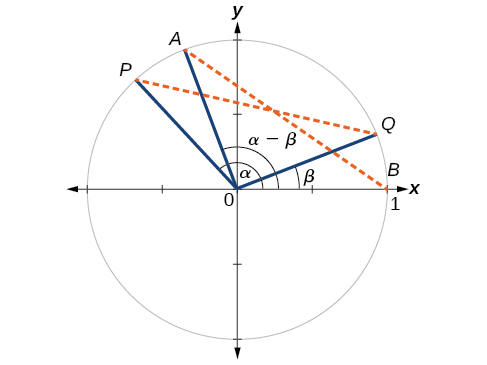
Figure
We can find the distance from
Since
Thus, we have the difference formula for cosine. We could use similar methods to derive the cosine of the sum of two angles.
Analysis: To completely prove the formula, we would have to consider other possibilities for
SUM AND DIFFERENCE FORMULAS FOR COSINE
These formulas can be used to calculate the cosine of sums and differences of angles.
 Given two angles, find the cosine of the sum or difference of the angles
Given two angles, find the cosine of the sum or difference of the angles
- Write the sum or difference formula for cosine.
- Substitute the values of the given angles into the formula.
- Simplify.
Example
Using the formula for the cosine of the difference of two angles, find the exact value of
Solution
Begin by writing the formula for the cosine of the difference of two angles. Then substitute the given values.
If you have a scientific calculator you can check the answer, making sure you use radian mode.
![]()
Find the exact value of
- Answer
-
Example
Find the exact value of
Solution
Since
If you have a scientific calculator you can check the answer, making sure you use degree mode.
Analysis
We could have also solved this problem using the fact that
![]()
Find the exact value of
- Answer
-
Using the Sum and Difference Formulas for Sine
The sum and difference formulas for sine can be derived in the same manner as those for cosine, and they are similar to the cosine formulas. (In what ways are they different?)
SUM AND DIFFERENCE FORMULAS FOR SINE
These formulas can be used to calculate the sines of sums and differences of angles.
 Given two angles, find the sine of the sum or difference of the angles.
Given two angles, find the sine of the sum or difference of the angles.
- Write the sum or difference formula for sine.
- Substitute the given angles into the formula.
- Simplify.
Example
Use the sum and difference identities to evaluate the difference of the angles and show that part a equals part b.
Solution
- Let’s begin by writing the sum formula and substitute the given angles.
Next, we need to find the values of the trigonometric expressions.
Now we can substitute these values into the equation and simplify.
- Now we write the difference formula and substitute the given angles.
Next, we find the values of the trigonometric expressions.
Now we can substitute these values into the equation and simplify.
Analysis
In both cases, we are calculating
Example
Find the exact value of
Solution
The pattern displayed in this problem is
Using the sum formula for sine,
Using the Sum and Difference Formulas for Tangent
Finding exact values for the tangent of the sum or difference of two angles is a little more complicated, but again, it is a matter of recognizing the pattern.
Finding the sum of two angles formula for tangent involves taking the quotient of the sum formulas for sine and cosine and simplifying. Recall,
Let’s derive the sum formula for tangent.
We can derive the difference formula for tangent in a similar way.
SUM AND DIFFERENCE FORMULAS FOR TANGENT
These formulas can be used to find the sum and difference for tangent:
 Given two angles, find the tangent of the sum or difference of the angles
Given two angles, find the tangent of the sum or difference of the angles
- Write the sum or difference formula for tangent.
- Substitute the given angles into the formula.
- Simplify.
Example
Find the exact value of
Solution
Let’s first write the sum formula for tangent and then substitute the given angles into the formula.
![]()
Find the exact value of
- Answer
-
Example
Given
Solution
We can use the sum and difference formulas to identify the sum or difference of angles when the ratio of sine, cosine, or tangent is provided for each of the individual angles. To do so, we construct what is called a reference triangle to help find each component of the sum and difference formulas.
- To find
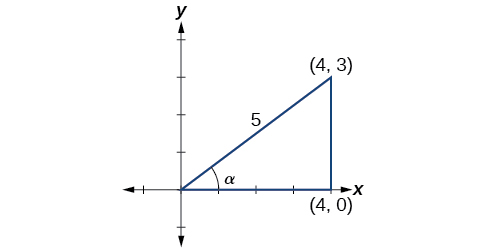
Figure
Since
Since
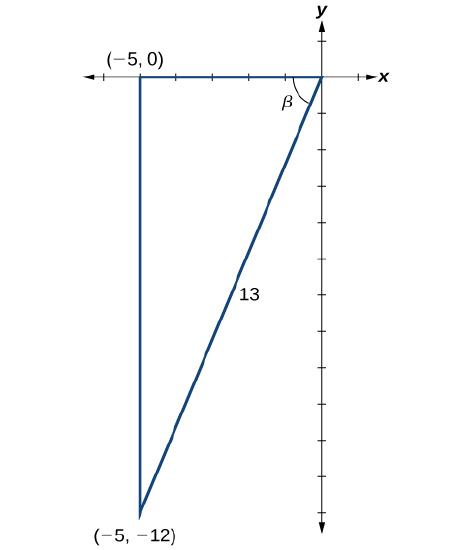
Figure
The next step is finding the cosine of
- We can find
- For
If
Then,
- To find
Analysis
A common mistake when addressing problems such as this one is that we may be tempted to think that
Using Sum and Difference Formulas for Cofunctions
We can use the sine, cosine, and tangent functions for the sums and differences of angles, to evaluate their cofunctions. You may recall from Right Triangle Trigonometry that, if the sum of two positive angles is
Notice also that
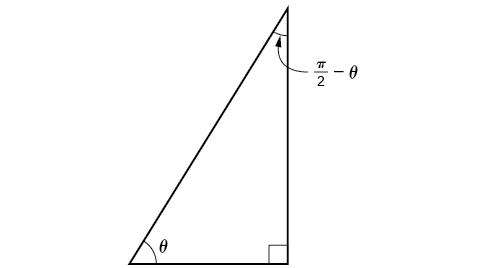
Figure
From these relationships, the cofunction identities are formed. Recall that you first encountered these identities in The Unit Circle: Sine and Cosine Functions.
COFUNCTION IDENTITIES
The cofunction identities are summarized in Table
Notice that the formulas in the table may also be derived algebraically using the sum and difference formulas. For example, using
We can write
Using the Sum and Difference Formulas to Verify Identities
Verifying an identity means demonstrating that the equation holds for all values of the variable. It helps to be very familiar with the identities or to have a list of them accessible while working the problems. Reviewing the general rules presented earlier may help simplify the process of verifying an identity.
 Given an identity, verify using sum and difference formulas
Given an identity, verify using sum and difference formulas
- Begin with the expression on the side of the equal sign that appears most complex. Rewrite that expression until it matches the other side of the equal sign.
- Look for opportunities to use the sum and difference formulas.
- Rewrite sums or differences of quotients as single quotients.
- If the process becomes cumbersome, rewrite the expression in terms of sines and cosines.
Example
Verify the identity
Solution
We will work on the left side of the equation, which includes the sines of the sum and the difference of angles. We can rewrite each using the sum and difference formulas.
The identity is verified.
Example
Verify the following identity.
Solution
We begin by rewriting the numerator on the left side of the equation.
![]()
Verify the identity:
- Answer
-
Example
For a climbing wall, a guy-wire
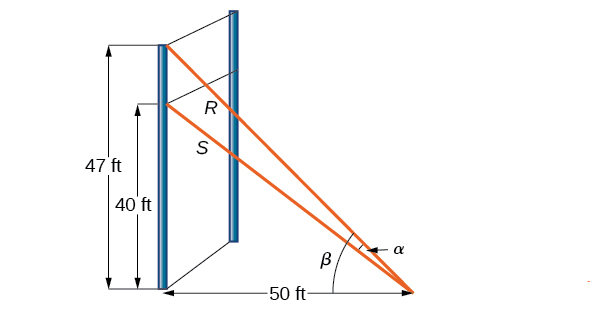
Figure
Solution
Let’s first summarize the information we can gather from the diagram. As only the sides adjacent to the right angle are known, we can use the tangent function. Notice that
Media
Access these online resources for additional instruction and practice with sum and difference identities.
Key Equations
| Sum Formula for Cosine | |
| Difference Formula for Cosine | |
| Sum Formula for Sine | |
| Difference Formula for Sine | |
| Sum Formula for Tangent | |
| Difference Formula for Tangent | |
|
Cofunction identities |
|
Key Concepts
- The sum formula for cosines states that the cosine of the sum of two angles equals the product of the cosines of the angles minus the product of the sines of the angles. The difference formula for cosines states that the cosine of the difference of two angles equals the product of the cosines of the angles plus the product of the sines of the angles.
- The sum formula for sines states that the sine of the sum of two angles equals the product of the sine of the first angle and cosine of the second angle plus the product of the cosine of the first angle and the sine of the second angle. The difference formula for sines states that the sine of the difference of two angles equals the product of the sine of the first angle and cosine of the second angle minus the product of the cosine of the first angle and the sine of the second angle.
- The sum formula for tangent states that the tangent of the sum of two angles equals the sum of the tangents of the angles divided by
- The sum and difference formulas can be used to find the exact values of the sine, cosine, or tangent of an angle. See Examples
- The sum and difference formulas for sine and cosine can also be used for inverse trigonometric functions. See Example
- The Pythagorean Theorem along with the sum and difference formulas can be used to find multiple sums and differences of angles. See Example
- Sum and difference formulas are useful in verifying identities. See Example
- Application problems are often easier to solve by using sum and difference formulas. See Example
Contributors
Jay Abramson (Arizona State University) with contributing authors. Textbook content produced by OpenStax College is licensed under a Creative Commons Attribution License 4.0 license. Download for free at https://openstax.org/details/books/precalculus.


